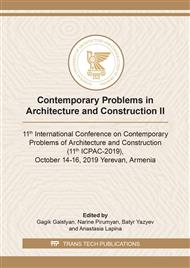[1]
Ko H Y, Masson R M., Nonlinear c haracterization and analysis of sand [J]. Numerical Methods in Geomechanics, American Society of Civil Engineering, (1976).
Google Scholar
[2]
Sun Yuesong, Pu Jialiu, Li Guangxin, Influence of different stress paths on stress-strain relation for sand[J], Chinese Journal of Geotechnical Engineering. 9 (6) (1987) 78-88. (in Chinese).
Google Scholar
[3]
Nakai T., An isotropic hardening elastoplastic model considering the stress path dependency in threedimensionalstresses[J], Soils and Foundations. 29 (1) (1989) 119-139.
DOI: 10.3208/sandf1972.29.119
Google Scholar
[4]
Yao Y P,Luo T,Sun D A,Matsuoka H. A., Simple 3-D constitutive model for both clay and sand[J], Chinese Journal of Geotechnical Engineering, 2002, 24(2): 240-246.
Google Scholar
[5]
Shi Weicheng, Zhu Jungao, He Shunbin, et al. Stress-induced anisotropy of coarse-grained soil by true triaxialtests[J]. Chinese Journal of Geotechnical Engineering. 32 (5) (2010) 810-814. (in Chinese).
Google Scholar
[6]
Lai Yong, Studying of sands constitutvie model that including the influencing factor of stress path at small strain[D], Nanjing: Hohai University, 2005. (in Chinese).
Google Scholar
[7]
Roscoe K H, Burland J B., On the generalized stress-strain behaviour of wet clay[J]. Engineering Plasticity, (1968).
Google Scholar
[8]
WeiXing,Huang Maosong, Anisotropic bounding surface model for natural structured clays [J], Chinese Journal of Geotechnical Engineering. 29 (8) (2007) 1225-1229. (in Chinese).
Google Scholar
[9]
Yao Y P, Hou W, Zhou A N. UH model: three-dimensional unified hardening model for overconsolidatedclays[J].Geotechnique. 59 (5) (2009) 451-469.
DOI: 10.1680/geot.2007.00029
Google Scholar
[10]
Wang Zhanjun, Chen Shengshui, Fu Zhongzhi, Viscoelastic-plastic constitutive model for creep deformation of rockfillmaterials[J], Chinese Journal of Geotechnical Engineering. 36 (12) (2014) 2188-2194. (in Chinese).
Google Scholar
[11]
Yang Guanghua, Yao Jie, Wen Yong. Elastic-plastic model for soils considering quasi-elastic-plastic deformation[J], Chinese Journal of Geotechnical Engineering. 35 (8) (2013) 1496-1503. (in Chinese).
Google Scholar
[12]
Shen Zhujiang. The rational form of elastoplastic stress-strain relation of soil[J], Chinese Journal of Geotechnical Engineering. 2(2) (1980) 11-19. (in Chinese).
Google Scholar
[13]
Duan Jianli, Chen Yuyao, Zheng Yingren. Study on the yield surface in generalized plastic mechanics[J], Chinese Journal of Rock Mechanics and Engineering. 21 (5) (2002) 617-620. (in Chinese).
Google Scholar
[14]
Balasubramaniam A S, Chaudry A R., Deformation and strength characteristics of soft Bangkok clay[J], Journal of Geotechnical Engineering. 104 (9) (1978) 1153-1167.
DOI: 10.1061/ajgeb6.0000685
Google Scholar
[15]
Hong W P, Lade P V., Strain increment and stress directions in torsion shear tests[J], Journal of Geotechnical Engineering. 115 (10) (1989) 1388-1401.
DOI: 10.1061/(asce)0733-9410(1989)115:10(1388)
Google Scholar
[16]
Luo Ting, Yao Yangping, Hou Wei, Soil Constitutive Models[M]. Beijing, China Communications Press, 2010. (in Chinese).
Google Scholar
[17]
Huang Maosong, Yao Yangping, Yin Zhenyu, Liu Enlong, Lei Huayang, An overview on elementary mechanical behaviors, constitutive modeling and failure criterion of soils[J], China Civil Engineering Journal. 49 (7) (2016) 9-35. (in Chinese).
Google Scholar


